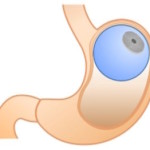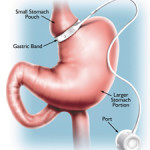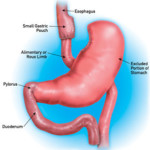Home | Surgical Weight Loss / Obesity Surgery | Laparoscopic Sleeve Gastrectomy | Laparoscopic Gastric Bypass | Laparoscopic Gastric Banding
LAPAROSCOPIC SLEEVE GASTRECTOMY
The World’s Preferred Weight Loss Procedure
Over the last 10 years, Sleeve Gastrectomy has become the most performed weight loss operation throughout the world. According to statistics, in the United Arab Emirates, 8 out of 10 weight loss procedures are Sleeve Gastrectomies. The reason for this popularity is predictable and enduring weight loss, coupled with the relative lack of long term complications.
What is Sleeve Gastrectomy?
Sleeve Gastrectomy is a weight loss procedure which involves reducing the size of the stomach to about a volume of 120 to 150 ml. The surgery is carried out laparoscopically using small keyhole incisions. The stomach is stapled and cut at the same time using a stapling device and sutures are applied to reinforce the staple line to minimize the chances of a leak.
How does the Sleeve Gastrectomy work?
Weight loss following sleeve gastrectomy occurs due to several reasons:
- A reduction in the volume of food that can be consumed at a time.
- A significant reduction in the levels of Ghrelin, a hormone responsible for generating hunger. Many patients also report a significant change in their food preferences, especially an aversion to sugars and carbohydrates.
- Inability of the residual stomach to expand, as the stretchable part of the stomach is removed and the part that is left behind is relatively less compliant. This makes the stomach able to accommodate a moderate intake of food, but does not allow one to overeat.
- The passage of food through the stomach is accelerated leading to early satiety which in effect reduces the intake without affecting the sense of satisfaction from eating.
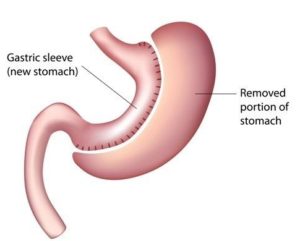
Health benefits beyond Weight Loss
There are numerous other benefits from this operation that can improve the health of the person in remarkable ways. In some cases, resolution of co-morbidities is well-established following Laparoscopic Sleeve Gastrectomy.
An analysis of several clinical studies, with a follow-up period of one to five years, has found that:
- More than 80% of patients had improvement or remission of Type 2 Diabetes Mellitus
- 77% resolved their High Cholesterol
- 50% did not require medication for Hypertension immediately following the surgery
- There was resolution of Sleep Apnea in over 60% of patients with this condition
These other health benefits are only partly due to the weight loss itself. Several well-conducted studies have demonstrated a profound change in the hormones that regulate the body chemistry and it is these hormonal changes that contribute to this dramatic improvement in the “biochemical health” of the person.
A 20-year long study conducted in Europe had shown clear evidence of a reduction in the incidence of heart disease, and death due to heart disease, in those who had bariatric surgery compared to those who did not (R).
Other benefits of Weight Loss surgery in the long term that have been found through several clinical studies include:
- Significant improvement in Arthritis and Chronic back pain
- Reversal of Polycystic Ovarian Syndrome
- Improvement in fertility reduction
- Reduction in the risk of Breast Cancer, Ovarian and Endometrial Cancer
- Better Quality of Life: Clinical studies of laparoscopic bariatric and metabolic surgery patients found that they felt better after the procedure, and spent more time doing recreational and physical activities. They also benefited from enhanced productivity and economic opportunities and had more self-confidence than they did prior to surgery.
It is projected that Bariatric Surgery adds 5-7 healthy years to a person’s lifespan ( R)
How to Prepare prior to Laparoscopic Sleeve Gastrectomy?
As with most surgeries, there are some steps in the preparation of your surgery that are designed to minimise complications during and after the surgery and to optimise the body’s ability to recover and heal without any adverse effects.
- A set of blood tests is required to evaluate your general fitness for the operation.
- An Ultrasound scan of the abdomen will be required to evaluate the size of the liver and the presence of gallstones or other upper abdominal conditions that may require attention during the surgery.
- A Gastroscopy may sometimes be required to evaluate the condition of the stomach and for the presence of a Hiatal Hernia, especially in patients complaining of recurrent acid reflux.
- A physician may be asked to evaluate your general health, especially in those who may suffer from Diabetes, Hypertension, Heart Disease or other related co-morbidities.
- A pre-surgery diet regime 2 weeks prior to surgery is advised which includes the elimination of all fatty foods to shrink the liver size and make the surgery safer. Protein and Vitamin supplements are advised to build up a reserve in anticipation of a relative lack of nutrition in the first two weeks after surgery when only liquids are allowed to be consumed.
How is Laparoscopic Sleeve Gastrectomy performed?
 Mobilising The Stomach
Mobilising The Stomach
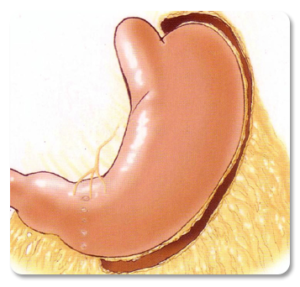
Stapling
The stomach is stapled with a calibration tube inside to ensure a residual volume of 120 to 150 ml.
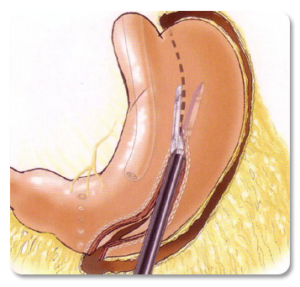
Staple Line Augmentation
The staple line is oversewn to reinforce the staple line and the attachments of the stomach as restored. The rest of the stomach (around 60-70% is removed through one of the keyholes. The removal of the upper part of the stomach fully is a key step in the procedure that results in the reduction of the hormone Ghrelin.
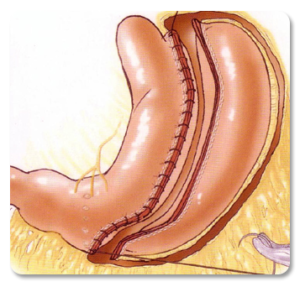
Leak Test: A stress test using a dye is carried out at the end of the procedure to ensure the absence of weak areas that may potentially leak later and these are oversewn again until the surgeon is satisfied that the stomach is rendered leak-proof.
Procedure Videos
The Immediate period after the operation
Since the operation is performed using minimally invasive techniques, the recovery following a Sleeve Gastrectomy is quite rapid. The average hospital stay is just overnight unless there are other health reasons to keep the patient in the hospital for a longer period. Drinking of clear fluids is started two to four hours after return to the ward. The patient is encouraged to move about and be out of bed from the evening after the surgery. A Respirometer (a breathing stimulation device) is used to encourage deep breathing to minimise the chances of lung collapse and infection. Pain after the operation is controlled using drugs that do not make a person drowsy but are still very effective in controlling pain. Some patients may experience nausea, but again this is controlled well with effective drugs to counteract this tendency.
Discharge from the Hospital
When the surgeon is satisfied that the clinical condition is stable, and the patient is able to drink at least 2 litres of liquids in a day, and pain is under control, it’s time to go home. Some medications will be prescribed primarily to control pain and to prevent clots in the leg. Most patients are able to go home in the afternoon the day after the surgery. Bed rest is not required or desirable after a Sleeve Gastrectomy. You are encouraged to be ambulant and this helps to accelerate the recovery process. Most patients are back to work one week after their operation
What are the Advantages of Sleeve Gastrectomy?
- The stomach is reduced in volume but tends to function normally so most food items can be consumed, albeit in small amounts.
- Eliminates the portion of the stomach that produces the hormones that stimulate hunger (Ghrelin).
- No dumping syndrome because the pylorus is preserved.
- Minimises the chance of an ulcer occurring.
- By avoiding the intestinal bypass, the chance of intestinal obstruction (blockage), anaemia, osteoporosis, protein deficiency and vitamin deficiency are almost eliminated.
- Very effective as a first stage procedure for high BMI patients (BMI > 50 kg/m2).
- Results appear promising as a single stage procedure for low BMI patients (BMI 35-45 kg/m2).
- Appealing option for people with existing anaemia, Crohn’s disease and numerous other conditions that make them too high risk for intestinal bypass procedures.
- Can be done laparoscopically in patients weighing over 225 kg.
- It can be converted/upgraded to almost any other weight loss procedure.
Post-op dietary plan following Sleeve Gastrectomy
A carefully designed dietary plan follows the surgery. Patients must stick to a liquid-based diet for 2 weeks after surgery. A soft Diet follows for a further 2 weeks. About 4-5 weeks after the operation, patients graduate to a 600-800 calorie/ day solid diet. Generally, patients are able to consume a reasonable meal around 6 months after surgery.
Bariatric Surgery is a starting point to changing the eating behaviour that led to the weight gain. It’s important to remember that if these habits do not change after the operation, one finds it difficult to lose weight or regain weight later.
Long-Term Weight-Loss Results
On average, patients who undergo Sleeve Gastrectomy experience 60-80% loss of excess weight. The rate of weight loss is generally quite predictable following the operation. In the first month, it will be in the range of 6-10 kgs of weight loss. By 3 months, we expect to reach around 18 kgs of weight loss on an average. By 6 months, it would be in the range of 22 -26 kgs. And thereafter 2-3 kgs a month until the target weight is reached.
Home | Surgical Weight Loss / Obesity Surgery | Laparoscopic Sleeve Gastrectomy | Laparoscopic Gastric Bypass | Laparoscopic Gastric Banding




